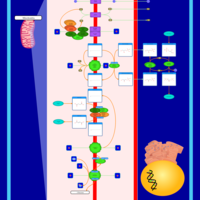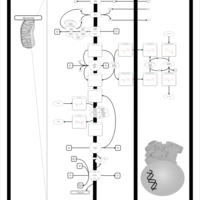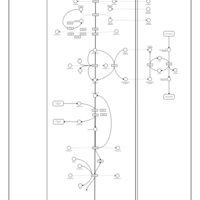| Oxidative phosphorylation |    |
| Tyrosine metabolism |    |
| Glycine, serine and threonine metabolism |    |
| Arginine and proline metabolism |    |
| beta-Alanine metabolism |    |
| Lysine degradation |    |
| Sulfur metabolism |    |
| Purine metabolism |    |
| Tyrosine metabolism |    |
| Primary bile acid biosynthesis |    |
| Tryptophan metabolism |    |
| Valine, leucine and isoleucine degradation |    |
| Inositol phosphate metabolism |    |
| Nicotinate and nicotinamide metabolism |    |
| Phenylalanine and Tyrosine Metabolism |    |
| Cysteine Metabolism |    |
| Vitamin B6 Metabolism |    |
| Taurine and Hypotaurine Metabolism |    |
| Steroid Biosynthesis |    |
| Porphyrin Metabolism |    |
| Caffeine Metabolism |    |
| Oxidation of Branched Chain Fatty Acids |    |
| Methionine Metabolism |    |
| D-Arginine and D-Ornithine Metabolism |    |
| Histidine metabolism |    |
| Ubiquinone Biosynthesis |    |
| Aspartate Metabolism |    |
| Androgen and Estrogen Metabolism |    |
| Riboflavin Metabolism |    |
| Retinol Metabolism |    |
| Arachidonic Acid Metabolism |    |
| Piroxicam Action Pathway |    |
| Ibandronate Action Pathway |    |
| Simvastatin Action Pathway |    |
| Acetylsalicylic Acid Action Pathway |    |
| Etodolac Action Pathway |    |
| Ketoprofen Action Pathway |    |
| Ibuprofen Action Pathway |    |
| Rofecoxib Action Pathway |    |
| Pravastatin Action Pathway |    |
| Rosuvastatin Action Pathway |    |
| Diclofenac Action Pathway |    |
| Sulindac Action Pathway |    |
| Alendronate Action Pathway |    |
| Celecoxib Action Pathway |    |
| Ketorolac Action Pathway |    |
| Lovastatin Action Pathway |    |
| Suprofen Action Pathway |    |
| Bromfenac Action Pathway |    |
| Indomethacin Action Pathway |    |
| Meloxicam Action Pathway |    |
| Zoledronate Action Pathway |    |
| Mefenamic Acid Action Pathway |    |
| Cerivastatin Action Pathway |    |
| Risedronate Action Pathway |    |
| Oxaprozin Action Pathway |    |
| Nabumetone Action Pathway |    |
| Valdecoxib Action Pathway |    |
| Pamidronate Action Pathway |    |
| Fluvastatin Action Pathway |    |
| Naproxen Action Pathway |    |
| Steroidogenesis |    |
| Atorvastatin Action Pathway |    |
| 2-Methyl-3-Hydroxybutryl CoA Dehydrogenase Deficiency |    |
| 3-Hydroxy-3-Methylglutaryl-CoA Lyase Deficiency |    |
| 3-Methylglutaconic Aciduria Type I |    |
| 3-Methylglutaconic Aciduria Type III |    |
| 3-Methylglutaconic Aciduria Type IV |    |
| Adenosine Deaminase Deficiency |    |
| Adenylosuccinate Lyase Deficiency |    |
| AICA-Ribosiduria |    |
| Alkaptonuria |    |
| Aromatic L-Aminoacid Decarboxylase Deficiency |    |
| Beta-Ketothiolase Deficiency |    |
| Canavan Disease |    |
| Cystathionine Beta-Synthase Deficiency |    |
| Dihydropyrimidine Dehydrogenase Deficiency (DHPD) |    |
| Glutaric Aciduria Type I |    |
| Guanidinoacetate Methyltransferase Deficiency (GAMT Deficiency) |    |
| Hawkinsinuria |    |
| Histidinemia |    |
| Hypoacetylaspartia |    |
| Maple Syrup Urine Disease |    |
| Methylmalonic Aciduria |    |
| Molybdenum Cofactor Deficiency |    |
| Phenylketonuria |    |
| Prolidase Deficiency (PD) |    |
| Prolinemia Type II |    |
| Hypercholesterolemia |    |
| Purine Nucleoside Phosphorylase Deficiency |    |
| S-Adenosylhomocysteine (SAH) Hydrolase Deficiency |    |
| Tyrosinemia Type I |    |
| Xanthine Dehydrogenase Deficiency (Xanthinuria) |    |
| Methionine Adenosyltransferase Deficiency |    |
| Glycine N-methyltransferase Deficiency |    |
| Non Ketotic Hyperglycinemia |    |
| Propionic Acidemia |    |
| 3-Methylcrotonyl Coa Carboxylase Deficiency Type I |    |
| Isovaleric Aciduria |    |
| Saccharopinuria/Hyperlysinemia II |    |
| Dimethylglycine Dehydrogenase Deficiency |    |
| Sarcosinemia |    |
| Clopidogrel Action Pathway |    |
| Diflunisal Action Pathway |    |
| Congenital Bile Acid Synthesis Defect Type II |    |
| Cerebrotendinous Xanthomatosis (CTX) |    |
| Zellweger Syndrome |    |
| Familial Hypercholanemia (FHCA) |    |
| Congenital Bile Acid Synthesis Defect Type III |    |
| Lysosomal Acid Lipase Deficiency (Wolman Disease) |    |
| Phenytoin (Antiarrhythmic) Action Pathway |    |
| Lidocaine (Antiarrhythmic) Action Pathway |    |
| Vitamin A Deficiency |    |
| Methylenetetrahydrofolate Reductase Deficiency (MTHFRD) |    |
| Hypermethioninemia |    |
| Hereditary Coproporphyria (HCP) |    |
| Acute Intermittent Porphyria |    |
| Congenital Erythropoietic Porphyria (CEP) or Gunther Disease |    |
| Porphyria Variegata (PV) |    |
| GABA-Transaminase Deficiency |    |
| Leukotriene C4 Synthesis Deficiency |    |
| 17-Beta Hydroxysteroid Dehydrogenase III Deficiency |    |
| Hyperprolinemia Type II |    |
| Hyperprolinemia Type I |    |
| Arginine: Glycine Amidinotransferase Deficiency (AGAT Deficiency) |    |
| Ornithine Aminotransferase Deficiency (OAT Deficiency) |    |
| Lesch-Nyhan Syndrome (LNS) |    |
| Gout or Kelley-Seegmiller Syndrome |    |
| Tyrosinemia Type 2 (or Richner-Hanhart syndrome) |    |
| Tyrosinemia Type 3 (TYRO3) |    |
| Congenital Lipoid Adrenal Hyperplasia (CLAH) or Lipoid CAH |    |
| Adrenal Hyperplasia Type 5 or Congenital Adrenal Hyperplasia due to 17 Alpha-hydroxylase Deficiency |    |
| Adrenal Hyperplasia Type 3 or Congenital Adrenal Hyperplasia due to 21-hydroxylase Deficiency |    |
| Methylmalonate Semialdehyde Dehydrogenase Deficiency |    |
| Desmosterolosis |    |
| CHILD Syndrome |    |
| Chondrodysplasia Punctata II, X Linked Dominant (CDPX2) |    |
| Smith-Lemli-Opitz Syndrome (SLOS) |    |
| Lidocaine (Local Anaesthetic) Action Pathway |    |
| Codeine Action Pathway |    |
| Methadone Action Pathway |    |
| Imipramine Action Pathway |    |
| Desipramine Action Pathway |    |
| Citalopram Action Pathway |    |
| Fluoxetine Action Pathway |    |
| Azathioprine Action Pathway |    |
| Mercaptopurine Action Pathway |    |
| Disulfiram Action Pathway |    |
| Thioguanine Action Pathway |    |
| Nicotine Action Pathway |    |
| Etoposide Action Pathway |    |
| Teniposide Action Pathway |    |
| Cyclophosphamide Action Pathway |    |
| Ifosfamide Action Pathway |    |
| Ethanol Degradation |    |
| Phytanic Acid Peroxisomal Oxidation |    |
| Refsum Disease |    |
| Vitamin K Metabolism |    |
| Carnitine Synthesis |    |
| Degradation of Superoxides |    |
| Tamoxifen Action Pathway |    |
| Plasmalogen Synthesis |    |
| Dimethylglycine Dehydrogenase Deficiency |    |
| Hyperglycinemia, non-ketotic |    |
| Ureidopropionase Deficiency |    |
| Carnosinuria, carnosinemia |    |
| Tyrosinemia, transient, of the newborn |    |
| Tyrosine hydroxylase deficiency |    |
| Dopamine beta-hydroxylase deficiency |    |
| Beta-mercaptolactate-cysteine disulfiduria |    |
| Hypophosphatasia |    |
| Creatine deficiency, guanidinoacetate methyltransferase deficiency |    |
| Hyperornithinemia with gyrate atrophy (HOGA) |    |
| Hyperornithinemia-hyperammonemia-homocitrullinuria [HHH-syndrome] |    |
| L-arginine:glycine amidinotransferase deficiency |    |
| Cholesteryl ester storage disease |    |
| Hyper-IgD syndrome |    |
| Mevalonic aciduria |    |
| Wolman disease |    |
| Xanthinuria type I |    |
| Xanthinuria type II |    |
| 3-hydroxyisobutyric acid dehydrogenase deficiency |    |
| 3-hydroxyisobutyric aciduria |    |
| Isobutyryl-coa dehydrogenase deficiency |    |
| Isovaleric acidemia |    |
| Hyperlysinemia I, Familial |    |
| Hyperlysinemia II or Saccharopinuria |    |
| Sulfite oxidase deficiency |    |
| Monoamine oxidase-a deficiency (MAO-A) |    |
| Adenine phosphoribosyltransferase deficiency (APRT) |    |
| Mitochondrial DNA depletion syndrome |    |
| Myoadenylate deaminase deficiency |    |
| Aromatase deficiency |    |
| 17-alpha-hydroxylase deficiency (CYP17) |    |
| Homocystinuria-megaloblastic anemia due to defect in cobalamin metabolism, cblG complementation type |    |
| Pyridoxine dependency with seizures |    |
| 11-beta-hydroxylase deficiency (CYP11B1) |    |
| 21-hydroxylase deficiency (CYP21) |    |
| Corticosterone methyl oxidase I deficiency (CMO I) |    |
| Corticosterone methyl oxidase II deficiency - CMO II |    |
| Ibuprofen Metabolism Pathway |    |
| Etoposide Metabolism Pathway |    |
| Teniposide Metabolism Pathway |    |
| Cyclophosphamide Metabolism Pathway |    |
| Ifosfamide Metabolism Pathway |    |
| Tamoxifen Metabolism Pathway |    |
| Clopidogrel Metabolism Pathway |    |
| Lidocaine (Local Anaesthetic) Metabolism Pathway |    |
| Codeine Metabolism Pathway |    |
| Methadone Metabolism Pathway |    |
| Imipramine Metabolism Pathway |    |
| Desipramine Metabolism Pathway |    |
| Citalopram Metabolism Pathway |    |
| Nicotine Metabolism Pathway |    |
| Felbamate Metabolism Pathway |    |
| Carbamazepine Metabolism Pathway |    |
| Valproic Acid Metabolism Pathway |    |
| Venlafaxine Metabolism Pathway |    |
| Tramadol Metabolism Pathway |    |
| Levomethadyl Acetate Metabolism Pathway |    |
| Clomipramine Metabolism Pathway |    |
| Doxepin Metabolism Pathway |    |
| Nevirapine Metabolism Pathway |    |
| Celecoxib Metabolism Pathway |    |
| Fluoxetine Metabolism Pathway |    |
| Sorafenib Metabolism Pathway |    |
| Lamivudine Metabolism Pathway |    |
| Artemether Metabolism Pathway |    |
| Mycophenolic Acid Metabolism Pathway |    |
| Rosiglitazone Metabolism Pathway |    |
| Antipyrine Action Pathway |    |
| Antrafenine Action Pathway |    |
| Carprofen Action Pathway |    |
| Etoricoxib Action Pathway |    |
| Fenoprofen Action Pathway |    |
| Flurbiprofen Action Pathway |    |
| Magnesium salicylate Action Pathway |    |
| Lumiracoxib Action Pathway |    |
| Lornoxicam Action Pathway |    |
| Phenylbutazone Action Pathway |    |
| Nepafenac Action Pathway |    |
| Trisalicylate-choline Action Pathway |    |
| Tolmetin Action Pathway |    |
| Tiaprofenic Acid Action Pathway |    |
| Tenoxicam Action Pathway |    |
| Salsalate Action Pathway |    |
| Salicylate-sodium Action Pathway |    |
| Salicylic Acid Action Pathway |    |
| Acetaminophen Action Pathway |    |
| Apparent mineralocorticoid excess syndrome |    |
| 3-Beta-Hydroxysteroid Dehydrogenase Deficiency |    |
| 2-aminoadipic 2-oxoadipic aciduria |    |
| 27-Hydroxylase Deficiency |    |
| 3-Phosphoglycerate dehydrogenase deficiency |    |
| Cystinosis, ocular nonnephropathic |    |
| The Oncogenic Action of Succinate |    |
| The Oncogenic Action of Fumarate |    |
| Glutaminolysis and Cancer |    |
| Androstenedione Metabolism |    |
| Estrone Metabolism |    |